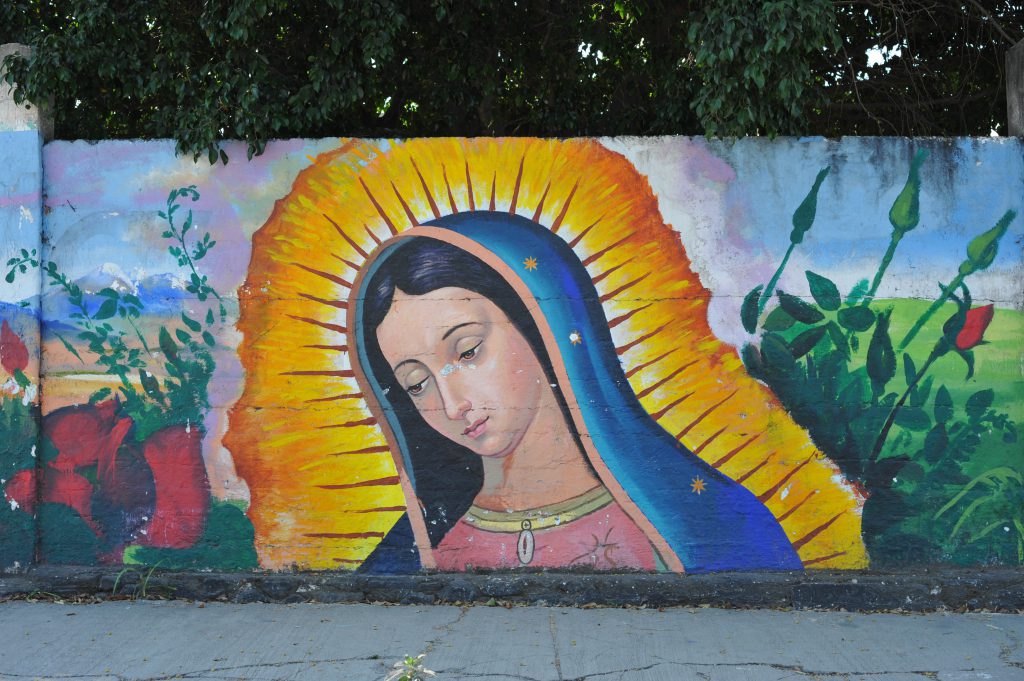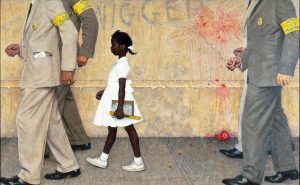Imagine waking up one day and going about your regular routine, when suddenly something happens that will not only change your life but the lives of Catholics and Mexicans forever.
At dawn on December 9, 1531, Juan Diego, who was a young Aztec Indian from the village of Cuautitlán, was on his way to attend weekly mass at the Franciscan church at Tlatelolco. He had recently converted to Catholicism, and the church was a few miles away from his uncle’s house, where he lived at after the death of his parents. While taking a shortcut over the hill of Tepeyac, he heard his name being called, and at the same time he heard music and the singing of birds.1 He followed the sounds and heard someone calling to him from the peak of the hill, “Juanito, Little Diego.” When he reached the top of the hill, he saw a young lady standing there who motioned for him to come closer: “Juanito, the smallest of my sons, where are you going?” He answered: “My Lady and my child, I have to go to your house in Mexico, Tlatelolco.” She declared herself to be “the eternal Virgin, holy Mother of the true God” and “merciful Mother” of men.2 She told Juan Diego to go to the bishop of Mexico, the Spaniard Fray Juan de Zumarraga, and tell him that she wished to have a church built on the hill of Tepeyac.3 This was the start of a life-changing moment for Juan Diego and soon, for Catholics all over the world.

Later that day, Juan Diego made his way to the bishop’s palace, which was about four miles away, and after some difficulty with the guards, he was eventually admitted to the bishop’s study, and he delivered the message from the Virgin Mary and told him everything that he admired, saw, and heard.4 The Bishop answered: “You will come again, my child, and I will think about the message you have brought.”5 Zumarraga was sympathetic but not convinced by the story that Juan Diego told him. As the first Catholic bishop of Mexico, he had heard many wild stories from converted Indians, and needed more time to think about it. In the recent decade, the colony of New Spain had been established after Hernan Cortes conquered the Aztecs in 1521. One of the goals of the Spanish was to convert the native indigenous population to Christianity. However, this was a very slow process. In many areas, the old religious practices were still being maintained a decade later. Some of the beliefs of the natives were incorporated into their own form of Christianity.6 Juan Diego left the bishop’s palace feeling very sad and returned to the hill where he had previously seen the Virgin, and explained to her what happened with the bishop, and suggested that it would be a better idea for her to send someone more important than he was to the bishop. The Virgin reassured him that he was the chosen one, and directed him to visit the bishop again the following day.7
The next day, on December 10, Juan Diego returned to the bishop’s palace and asked him if they could build the church for the Virgin Mary. The bishop asked him many questions in order to test his truthfulness, such as where he had seen her and how she looked, and Juan Diego answered everything precisely to the bishop.8 The bishop listened carefully but said he would need some proof before building a church for her. He directed Juan Diego to bring back an unmistakable sign for the validation of the apparitions that occurred. After Juan Diego left, the bishop then sent two of his staff to follow him and report back what they had seen. Juan Diego went back to the hill at Tepeyac and the staffers that were following him lost sight of him and returned back to the bishop’s palace. Meanwhile, Juan Diego had seen the Virgin Mary again, and told her the answer that the bishop had given him. She told him to come back the following day and she would give him a sign for the bishop.9
When he returned home, Juan Diego found his uncle, Juan Bernardino, seriously ill and at the point of dying. He nursed him all through the night. In the morning, he decided to call on a priest from the church at Tlatelolco to administer the last rites, as his uncle’s health was not improving. Juan Diego was worried that he had failed to meet with the Virgin Mary, and took the longer and lower road to Tlatelolco instead of the shortcut over the hill of Tepeyac. But the Virgin appeared on the lower path and told him that there was no need to worry about his uncle Bernardino, whom she had visited and was now cured. She then told Juan to go back to the top of the hill, where he would find many flowers growing. His mission was to pick a bunch of the flowers, wrap them in his cloak, and take them to the bishop. The Virgin stressed that these flowers must be concealed and not shown to anyone else.10

The top of the hill was not a place where flowers would usually grow, because of thorns, thistles, cactus, and small weeds. And it was the month of December, when everything is killed by the frost. However, he found some beautiful and fragrant roses growing, so he picked a bunch, wrapped them in his cloak, and headed down towards the Virgin to show her what he had discovered. The Virgin took them in her hands and told him that this bunch of flowers was the proof that he needed to show the bishop, and in showing him, the bishop would believe all that Juan Diego had said.11 He picked up the bunch of flowers, wrapped them in his cloak, and headed towards the bishop’s palace one last time, and upon arrival, the guards demanded to know what he was carrying in his cloak. The guards could smell the flowers and when they opened the cloak, the roses were fresh, fragrant, fully open, and precious. They took the cloak away from Juan and attempted to grab some of the flowers, but once they had opened it again and reached to grab some, the roses had become painted flowers on the inside of the cloak. They took Juan to the bishop and when he unfolded his white cloak to the bishop, the fresh roses spilled out onto the floor. When the various roses fell on the floor, the bishop saw that on the inside of the cloak where the flowers once had been, a portrait of the Virgin Mary appeared.12

When the bishop and all that were present saw this image, they fell to their knees in admiration. The bishop took the cloak to his chapel, where he then prayed and thanked God and the Virgin for the miracle. The bishop, astounded by this miracle, asked to be taken to where Juan Diego had seen the Virgin Mary. Upon arrival at the hill of Tepeyac, the bishop ordered that the church that the Virgin Mary had requested to be built would indeed be built, and would be named “The Basilica of Our Lady of Guadalupe,” which is located in present-day Mexico City. The cloak with the picture of Our Lady of Guadalupe can be found at this church that was built in her honor.13
It has been said that the dark-skinned image of Mother Mary as a virginal Native American girl helped the Spanish priests convert millions of Mexican Indians to Catholicism.14 Occasionally, we encounter a symbol that seems to enshrine the major hopes and aspirations of an entire society. Such a master symbol is represented by the Virgin of Guadalupe, Mexico’s patron saint. Her image was not only used during wars and battles as a figure of protection, but is also still used to adorns house fronts, churches and home altars, restaurants, and so much more. Her shrine at Tepeyac is visited each year by hundreds of thousands of pilgrims that all go to honor her.15 To the present day, Our Lady of Guadalupe remains a powerful symbol of Mexican identity and faith, and her image is associated with everything from motherhood to feminism to social justice. Her image has often graced the banners of those struggling for Mexican independence, and she has been understood by many devotees to side with oppressed and poor people. Mexican immigrants to the United States brought with them their devotion to her—privately and affectionately called “La Morenita”—and have helped to perpetuate her identification with others.16 After the apparitions of the Virgin Mary occurred, many Catholics began to honor her and see her as their own mother, especially Mexicans since they often refer to her as “nuestra Madre” or “Our Mother” and adopted her as their own. The feast of Our Lady of Guadalupe is celebrated every December 12, which became a national holiday in Mexico in 1859, and she has been recognized as the patron saint of Mexico.17

- Encyclopedia of Occultism and Parapsychology, 2001, s.v. “Guadalupe Apparitions (of the Virgin Mary)”, by J. Gordon Melton. ↵
- Samuel Marti, The Virgen of Guadalupe and Juan Diego (Ediciones Euroamericanas, 1973), 36-38. ↵
- Encyclopedia of Occultism and Parapsychology, 2001, s.v. “Guadalupe Apparitions (of the Virgin Mary)”, by J. Gordon Melton. ↵
- Encyclopedia of Occultism and Parapsychology, 2001, s.v. “Guadalupe Apparitions (of the Virgin Mary)”, by J. Gordon Melton. ↵
- Samuel Marti, The Virgen of Guadalupe and Juan Diego (Ediciones Euroamericanas, 1973), 39. ↵
- Global Events: Milestone Events Throughout History, 2014, s.v. “The Virgin of Guadalupe Appears to Juan Diego”, by Jennifer Stock. ↵
- Encyclopedia of Occultism and Parapsychology, 2001, s.v. “Guadalupe Apparitions (of the Virgin Mary)”, by J. Gordon Melton. ↵
- Samuel Marti, The Virgen of Guadalupe and Juan Diego (Ediciones Euroamericanas, 1973), 43. ↵
- Encyclopedia of Occultism and Parapsychology, 2001, s.v. “Guadalupe Apparitions (of the Virgin Mary)”, by J. Gordon Melton. ↵
- Encyclopedia of Occultism and Parapsychology, 2001, s.v. “Guadalupe Apparitions (of the Virgin Mary)”, by J. Gordon Melton. ↵
- Samuel Marti, The Virgen of Guadalupe and Juan Diego (Ediciones Euroamericanas, 1973), 48. ↵
- Encyclopedia of Occultism and Parapsychology, 2001, s.v. “Guadalupe Apparitions (of the Virgin Mary)”, by J. Gordon Melton. ↵
- Global Events: Milestone Events Throughout History, 2014, s.v. “The Virgin of Guadalupe Appears to Juan Diego”, by Jennifer Stock. ↵
- The Gale Encyclopedia of the Unusual and Unexplained, 2003, s.v. “Virgin of Guadalupe,” by Brad Steiger and Sherry Hanson Steiger. ↵
- Eric R. Wolf, “The Virgin of Guadalupe: A Mexican National Symbol,” The Journal of American Folklore 71, no. 279 (1958): 1. ↵
- Contemporary American Religion, 1999, s.v. “Virgin of Guadalupe,” by Sandra L. Zimdars-Swartz. ↵
- Contemporary American Religion, 1999, s.v. “Virgin of Guadalupe,” by Sandra L. Zimdars-Swartz. ↵



103 comments
Rinnu Joy
I love to read catholic articles about saints and other christian virtues. I loved reading this article of Juan Diego’s vision and his faithfulness which made him to interact with Mother Mary and by his actions to build a church in the hill top. The scene explaining the evidence of roses were really interesting that talked very well about the intervention on Holy Mary.
Congratulations for the great work!
Alin Bocardo Felix
I was raised Catholic and this is a well-known story, one of the instances that really makes one question their faith. I say this because if something like this occurred to someone, then it is possible that all other aspects of the faith are true. The article is very well written and includes all the details which I remember reading about. The imagery created is respectful of the church and therefore welcome to the faith.
Octaviano Ibarra
Honestly, I enjoy learning more about my religion especially the smaller stories that have a huge impact like this one of the Virgen of Guadalupe, or like the meaning of the original sin. I understood most of the article but did not get a full grasp of the beginning with Juan Diego and the Virgen’s first interaction. I was lost on how the interaction first came to be.
Sebastian Azcui
I have heard this story before as I am Catholic, and follow la Virgen de Guadalupe. It is very inspiring and nice how Virgen de Guadalupe and Juan Diego spread the Catholic influence and had such a great impact on Mexican culture. Virgen de Guadalupe is admired by many around Mexico and is a strong influence as many people believe in her.
Nelly Perez
I have always wondered about the meaning of Guadalupe while learning about the catholic faith in high school. There were so many holidays in the Catholic Church that I did not know much about since I was raised in the Christian faith. She has been a great part of a culture and in the church as well. Many people have prayed to her for help and she keeps their faith strong. I remember hearing about the feast, but I never took part in it. After reading this article, it helped me understand more of the culture and her back story.
Vania Gonzalez
This article is very good and it really shows how important the Virgin de Guadalupe is to the Mexican culture. As a catholic, you hear stories like these all the time but I had never heard this one about Juan Diego and it is a beautiful story so thank you for this article. Without Juan diego and the cloak then we would not have a strong belief in the Virgin de Guadalupe this story just really shows how important she is to the culture.
Eliezer Leal
This story always brings me joy and fills me with hope. I love The Virgen de Guadalupe, and I have prayed to her, she is a mother to all. The story of Juan Diego is one of my all time favorites that I never get tired of hearing. Being able to see and speak to The Virgen is truly a blessing, I can’t believe what must’ve been going through Juan Diego’s mind when he net her
Rosa Robledo Martinez
I am catholic and as I was growing up we would always go to church around Christmas time there would always be a play about Juan Diego and his encounter with La Virgen de Guadalupe. I would always admire that he would always try to tell people that he saw her and no one believed him. I think that everyday he walked passed by where he would see her, he would bring her flowers. I think Juan Diego was a major part of the catholic beliefs. I honestly think that La Virgen de Guadalupe is a powerful saint that always guides us.
Mitchell Yocham
It’s weird to think that even though I am catholic there are so many stories and miracles that we don’t hear or read about. This is one of the stories that I’ve never heard about and it just truly amazes me because although so many people can doubt Catholicism, miracles still happen. The virgin of Guadalupe has also helped so many people get through struggles simply by praying and thanking her for her presence. This saint is truly amazing in everything that she does.
Samantha Bonillas
The history of the Virgin of Guadalupe is one that I grew up frequently hearing. My whole life I have prayed to, being a practicing Catholic and all, and I think that it is so crazy that people can have faith. She is the definition of being one who struggled and found their way to Christ. Not only does the Virgin of Guadalupe have an impact within the Catholic church but in the Mexican culture was well. This article made me remember some of the details in the story that I had forgotten, like the significance of the roses. Her story is amazing.